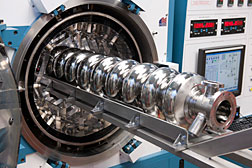- Number 364 |
- June 4, 2012
Fermilab adds sparkle to new generation of particle accelerators

A superconducting accelerator cavity
emerges from a vacuum oven at Fermilab.
A new generation of powerful accelerators relies on superconducting niobium cavities as the technology of choice. These devices can propel more particles in a shorter distance than conventional accelerator technologies.
At DOE’s Fermi National Accelerator Laboratory, scientists are collaborating with industry and national laboratories to optimize manufacturing processes for these cavities and build an advanced prototype accelerator. The research helps reduce the cost of these accelerators and paves the way for future applications.
To get the maximum performance from these cavities, their interior surfaces should be free from defects and as smooth as possible. Using a custom-built tumbler and experimenting with unique polishing materials, a team at Fermilab has now developed an efficient and environmentally friendly way of creating ultra-smooth cavity surfaces. Tests have revealed that cavities polished with this innovative process can propel particles with more than 30 million volts per meter.
There are more than 30,000 particle accelerators (watch 2-minute video) in operation around the world. They shrink tumors, make better tires, spot suspicious cargo, clean up dirty drinking water, help design drugs, discover the building blocks of matter, and do much more (see Symmetry Magazine). Future industrialization of these superconducting accelerators could change the way companies do business and create new applications in medicine, manufacturing, energy, national security, environment and discovery science.[Kurt Riesselmann, 630-840-3351,
kurtr@fnal.gov]
